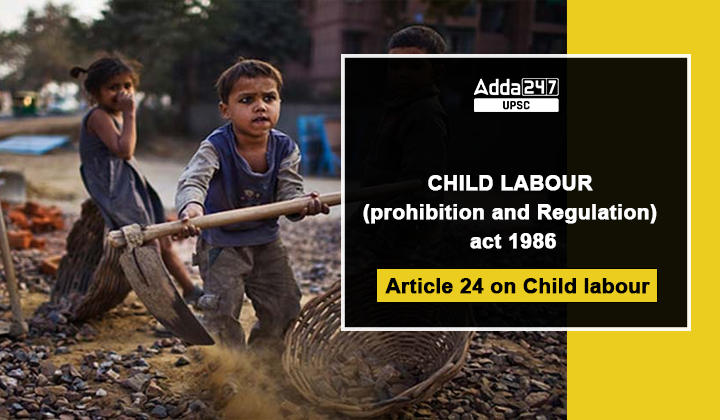Table of Contents
Introduction to the Child Labour Act 1986
Child labour refers to the exploitative practice of involving children in economic activities, either part-time or full-time, depriving them of their basic rights and experiences of childhood. These children are often denied access to education and bear the physical and psychological consequences of such exploitation.
The prevalence of child labour can be attributed to factors such as poverty, inadequate access to quality education, and the growth of the informal economy. As a result, children are forced into labour, sacrificing their education and overall well-being.
Engaging in child labour robs children of a nurturing and healthy environment necessary for their growth. They endure physical and mental suffering, leaving lasting scars. In addition to the lack of education, these children also face various forms of abuse, hindering their potential for a happy and prosperous adulthood.
Child Labour (Prohibition and Regulation) Act 1986
The Child Labour (Prohibition and Regulation) Act, 1986 is an Act of the Parliament of India that prohibits the employment of children in certain occupations and processes. The Act also regulates the working conditions of children in certain other employments. The Act prohibits the employment of children under the age of 14 years in any of the occupations and processes listed in the Schedule to the Act. These occupations and processes include:
- Transport of passengers, goods, or mails by railway;
- Manufacture of matches
- Asbestos industry
- Bidi-making
- Carpet-making
- Cement manufacturing
- Construction
- Glass blowing
- Handling of weights and measures
- Mining
- Printing
- Soap manufacturing
- Tannery
- Tobacco processing
- Welding
The Act also prohibits the employment of children under the age of 15 years in any other occupation or process that is hazardous to their health or safety. The Act also regulates the working conditions of children in certain other employments, such as those in the entertainment industry, hotels, and restaurants. These children are not prohibited from working, but their working hours are limited to 4 hours a day and 24 hours a week. They are also required to have a weekly holiday and a rest period of at least 1 hour after every 3 hours of work.
The Child Labour (Prohibition and Regulation) Act, of 1986 is an important piece of legislation that seeks to protect the rights of children and ensure that they are not exploited in the workplace. The Act has been successful in reducing the number of child labourers in India, but there is still more work to be done. The government and other stakeholders need to continue to raise awareness of the issue and enforce the provisions of the Act in order to ensure that all children have the opportunity to grow up healthy, safe, and educated.
Child Labour (Prohibition and Regulation) Amendment Rules, 2017
The Child Labour (Prohibition and Regulation) Amendment Rules, 2017 were notified by the Government of India on 2 June 2017. The Rules amended the Child Labour (Prohibition and Regulation) Act, 1986, and made the following changes:
- Permitted employment of children in family enterprises. The Rules permitted children below the age of 14 years to work in family enterprises, both hazardous and non-hazardous, if they are not engaged in any hazardous work.
- Increased the maximum working hours for children in certain employments. The Rules increased the maximum working hours for children in certain employments, such as the entertainment industry, hotels, and restaurants. Children in these employments are now allowed to work for up to 6 hours a day and 36 hours a week.
- Simplified the process of obtaining a certificate of permission for employing children. The Rules simplified the process of obtaining a certificate of permission for employing children. The application for a certificate of permission can now be made online, and the process is expected to be completed within 30 days.
- Increased the penalties for violating the Act. The Rules increased the penalties for violating the Act. The maximum penalty for employing a child in a hazardous occupation or process was increased from Rs. 20,000 to Rs. 50,000.
The Child Labour (Prohibition and Regulation) Amendment Rules, 2017 are a step in the right direction to protect the rights of children and ensure that they are not exploited in the workplace. The Rules have simplified the process of obtaining a certificate of permission for employing children, and they have increased the penalties for violating the Act. This will help to ensure that the provisions of the Act are enforced more effectively.
Key Provisions for Child Labour (Prohibition and Regulation) Act 1986
Here are some of the key provisions of the Act:
- Prohibition of employment of children in certain occupations and processes.
- Regulation of the working conditions of children in certain other employments.
- Establishment of a Technical Advisory Committee to advise the government on matters relating to the Act.
- Appointment of Inspectors to enforce the provisions of the Act.
- Imposition of penalties for violations of the Act.
The Child Labour (Prohibition and Regulation) Act, of 1986 is an important piece of legislation that has helped to reduce the number of child labourers in India. However, there is still more work to be done to ensure that all children have the opportunity to grow up healthy, safe, and educated.
| Relatable Articles | |
| Payment of Wages Act 1936 | Industrial Disputes Act 1947 |
| Wildlife Protection Act 1972 | National Food Security Act 2013 |
| Dowry Prohibition Act 1961 | Muslim Woman Act 2019 |
| Follow US | |
| UPSC Govt. Jobs UPSC Current Affairs UPSC Judiciary PCS Download Adda 247 App here to get the latest updates |


 TSPSC Group 1 Question Paper 2024, Downl...
TSPSC Group 1 Question Paper 2024, Downl...
 TSPSC Group 1 Answer key 2024 Out, Downl...
TSPSC Group 1 Answer key 2024 Out, Downl...
 Cabinet Ministers of India 2024, New Cab...
Cabinet Ministers of India 2024, New Cab...







